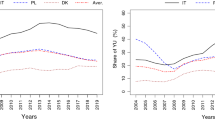Abstract
Youth first footsteps at the labour market (LM) affect the further career and also relate to other life domains. The trajectories depend not only on the personal characteristic of the young person but also on the institutional settings, especially on educational system, labour market regulations, employment policies and overall economic climate. Therefore, the labour market transition sequences could take different paths in different countries.
This chapter provides an insight into youth labour market trajectories specific to countries of Central and Eastern Europe (CEE). The first part describes the role of institutions in labour market transitions providing an overview of institutional disparities, and similarities across the CEE countries. Analytical part follows, in which microdata from the EU statistics on income and living conditions (EU-SILC) datasets are used to depict labour market transitions of young people, with different educational attainment from CEE and EU benchmark countries: Finland, Austria, the UK and Italy.
Access this chapter
Tax calculation will be finalised at checkout
Purchases are for personal use only
Similar content being viewed by others
Notes
- 1.
Type of stratification refers to the number and type of transitions to the next educational level.
- 2.
Standardization is the degree to which the quality of education meets the same standards nationwide (Allmendinger 1989: 46).
- 3.
OECD/IAB Employment Protection Database, 2013 update, see: www.oecd.org/employment/protection
- 4.
OECD.Stat Database, 2014, see: https://stats.oecd.org/Index.aspx?DataSetCode=LMPEXP#, Active measures 10–70, Passive measures 80.
- 5.
Ibid, 2013 data as 2014 not available for Poland.
- 6.
In our sample in comparison to the representative LFS data, there is a slight overrepresentation of those with upper secondary education and underrepresentation of youth with university degree.
- 7.
- 8.
Eurostat: participation rate in education and training by age [trng_aes_101], last update: 11-08-2015
- 9.
Eurostat: LMP expenditure (source: DG EMPL) [lmp_ind_exp], last update: 29-08-2016
References
Allmendinger, J. (1989). Education systems and labor market outcomes. European Sociological Review, 5(3), 231–250.
Baranowska, A. (2008). Poland. In I. Kogan, M. Gebel, & C. Noelke (Eds.), Europe enlarged: A handbook of education, labour and welfare regimes in central and Eastern Europe (pp. 269–294). Bristol: The Policy Press.
Bol, T., & van de Werfhorst, H. G. (2011). Signals and closure by degrees: The education effect across 15 European countries. Research in Social Stratification and Mobility, 29(1), 119–132.
Bol, T., & van de Werfhorst, H. G. (2013). Education systems and the trade-off between labor market allocation and equality of educational opportunity. Comparative Education Review, 57(2), 285–308.
Breen, R. (2005). Explaining cross-national variation in youth unemployment: Market and industrial factors. European Sociological Review, 21(2), 125–134.
Brzinsky-Fay, C. (2007). Lost in transition? Labour market entry sequences of school leavers in Europe. European Sociological Review, 23(4), 409–422.
Card, D., Kluve, J., & Weber, A. (2015). What works? A meta analysis of recent active labor market program evaluations. IZA DP No. 9236. Retrieved from http://ftp.iza.org/dp9236.pdf
De Lange, M., Gesthuizen, M., & Wolbers, M. H. J. (2014). Youth labour market integration across Europe. European Societies, 16(2), 194–212.
Esping-Andersen, G. (1990). The three worlds of welfare capitalism. Princeton: Princeton University Press.
Gangl, M. (2002). Changing labour markets and early career outcomes: Labour market entry in Europe over the past decade. Work, Employment and Society, 16(1), 67–90.
Gebel, M., & Giesecke, J. (2016). Does deregulation help? The impact of employment protection reforms on youths’ unemployment and temporary employment risks in Europe. European Sociological Review, 32(4), 486–500.
Kieselbach, T., Van Heeringer, K., La Rosa, M., Lemkow, L., Sokou, K., & Starrin, B. (Eds.). (2001). Living on the edge: An empirical analysis on long-term youth unemployment and social exclusion in Europe. Opladen: Leske+Budrich.
Kogan, I., Gebel, M., & Noelke, C. (Eds.). (2008). Europe enlarged: A handbook of education, labour and welfare regimes in central and Eastern Europe. Bristol: The Policy Press.
Levels, M., van der Velden, R., & Di Stasio, V. (2014). From school to fitting work: How education-to-job matching of European school leavers is related to education system characteristics. Acta Sociologica, 57(4), 341–361.
Marsden, D. (1990). Rules, groups, and labour markets. Journal of Behavioral Economics, 19(3), 305–319.
Martin, J. P., & Grubb, D. (2001). What works and for whom: A review of OECD countries’ experiences with active labour market policies. Swedish Economic Policy Review, 8(2), 9–56.
Müller, W. (2005). Education and youth integration into European labour market. International Journal of Comparative Sociology, 46, 461–485.
Müller, W., & Gangl, M. (Eds.). (2003). Transitions from education to work in Europe: The integration of youth into EU labour markets. Oxford: Oxford University Press.
O’Higgins, N. (2012). This time it’s different? Youth labour markets during “the great recession”. Comparative Economic Studies, 54(2), 395–412.
OECD. (2016a). Education at a glance 2016: OECD indicators. Paris: OECD Publishing. https://doi.org/10.1787/eag-2016-en.
OECD. (2016b). Youth unemployment rate (indicator). doi:https://doi.org/10.1787/c3634df7-en. Accessed 28 Nov 2016.
Rokicka, M., & Kłobuszewska, M. (2016). The short-term economic consequences of insecure labour market positions in EU-28. EXCEPT working papers, WP No. 10. Tallinn University, Tallinn. http://www.except-project.eu/working-papers/
Rokicka, M., Kłobuszewska, M., Palczyńska, M., Shapoval, N., & Stasiowski, J. (2015). Composition and cumulative disadvantage of youth across Europe. EXCEPT working papers, WP No 1. Tallinn University, Tallinn. http://www.except-project.eu/working-papers/
Russell, H., & O’Connell, P. J. (2001). Getting a job in Europe: The transition from unemployment to work among young people in nine European countries. Work, Employment and Society, 15(1), 1–24.
Ryan, P. (2001). The school-to-work transition: A cross-national perspective. Journal of Economic Literature, 39(1), 34–92.
Saar, E., Unt, M., & Kogan, I. (2008). Transition from educational system to labour market in the European Union: A comparison between new and old members. International Journal of Comparative Sociology, 49(1), 31–59.
Shavit, Y., & Müller, W. (Eds.). (1998). From school to work. A comparative study of educational qualifications and occupational destinations. Oxford: Oxford University Press.
Shavit, Y., Arum, R., & Gamoran, A. (Eds.). (2007). Stratification in higher education: Comparative study. Palo Alto: Stanford University Press.
Van der Velden, R. K. W., & Wolbers, M. H. J. (2003). The integration of young people into the labour market: The role of training systems and labour market regulation. Oxford: Oxford University Press.
Walther, A. (2006). Regimes of youth transitions. Young, 14(2), 119–139.
Wolbers, M. H. J. (2007). Patterns of labour market entry: A comparative perspective on school-to-work transitions in 11 European countries. Acta Sociologica, 50(3), 189–210.
Author information
Authors and Affiliations
Corresponding author
Editor information
Editors and Affiliations
Rights and permissions
Copyright information
© 2018 Springer International Publishing AG
About this chapter
Cite this chapter
Rokicka, M., Unt, M., Täht, K., Nizalova, O. (2018). Youth Labour Market in Central and Eastern Europe. In: Malo, M., Moreno Mínguez, A. (eds) European Youth Labour Markets. Springer, Cham. https://doi.org/10.1007/978-3-319-68222-8_5
Download citation
DOI: https://doi.org/10.1007/978-3-319-68222-8_5
Published:
Publisher Name: Springer, Cham
Print ISBN: 978-3-319-68221-1
Online ISBN: 978-3-319-68222-8
eBook Packages: Social SciencesSocial Sciences (R0)




